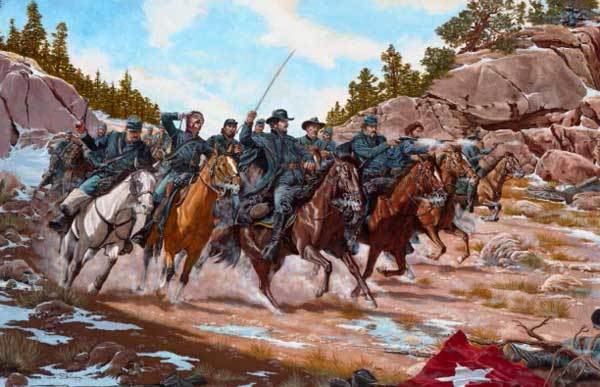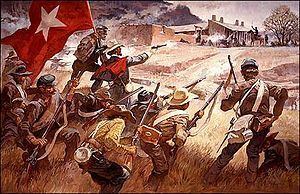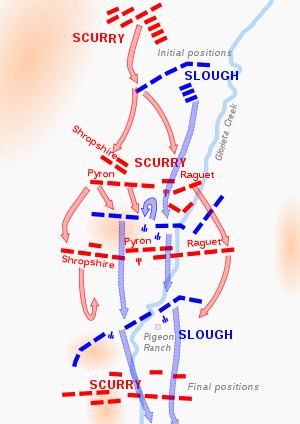1,300 1,100 | Dates 26 Mar 1862 – 28 Mar 1862 | |
Apache Canyon5 killed14 wounded3 missingGlorieta Pass46 killed64 wounded15 capturedTotal51 killed78 wounded15 captured3 missing147 total Apache Canyon4 killed20 wounded75 capturedGlorieta Pass46 killed60 wounded17 capturedTotal50 killed80 wounded92 captured222 total Results Confederate tactical victory;, Union strategic victory Similar American Civil War, Battle of Valverde, New Mexico Campaign, Battle of Picacho Pass, Battle of Pea Ridge | ||
Battle of glorieta pass
The Battle of Glorieta Pass, fought from March 26 to 28, 1862 in northern New Mexico Territory, was the decisive battle of the New Mexico Campaign during the American Civil War. Dubbed the "Gettysburg of the West" (a term that "serves the novelist better than the historian") by some authors, it was intended as the killer blow by Confederate forces to break the Union possession of the West along the base of the Rocky Mountains. It was fought at Glorieta Pass in the Sangre de Cristo Mountains in what is now New Mexico, and was an important event in the history of the New Mexico Territory in the American Civil War.
Contents
- Battle of glorieta pass
- New Mexico Campaign
- Battle
- Apache Canyon
- Glorieta Pass
- Johnsons Ranch
- Controversy
- Effects of the Federal victory
- Battlefield preservation
- Depictions in popular culture
- References

There was a skirmish on March 26 between advance forces from each army, with the main battle occurring on March 28. Although the Confederates were able to push the Union force back through the pass, they had to retreat when their supply train was destroyed and most of their horses and mules killed or driven off. Eventually, the Confederates had to withdraw entirely from the territory back into Confederate Arizona and then Texas. Glorieta Pass thus represented the climax of the campaign.
Battle of glorieta pass
New Mexico Campaign
The Confederacy had organized the Confederate Arizona Territory in 1862, a claim that included the southern halves of modern Arizona and New Mexico, after secession moves by residents. The territory had its capital at Mesilla, outside modern Las Cruces. The strategic aim was to capture the gold and silver mines in California and Colorado Territory and the ports in Southern California.

The commanders of the New Mexico Campaign were the Confederate brigadier general, Henry Hopkins Sibley, and the Union colonel, Edward Canby. Sibley, whose mission was to capture Fort Craig, outmaneuvered Canby at the Battle of Valverde in February and drove Canby back to his fort, but failed to force Canby's surrender. Instead, Sibley bypassed the fort, and advanced up along the Rio Grande Valley to seize Santa Fe, on March 10. Canby remained at Fort Craig to cut Sibley's logistical support from Texas and to await further reinforcements before resuming the offensive. Sibley set up his headquarters at the abandoned Union storehouse at Albuquerque.

In March, Sibley sent a Confederate force of 200 to 300 Texans under the command of Major Charles L. Pyron on an advance expedition over the Glorieta Pass, a strategic location on the Santa Fe Trail at the southern tip of the Sangre de Cristo Mountains southeast of Santa Fe. Control of the pass would allow the Confederates to advance onto the High Plains and to make an assault on Fort Union, the Union stronghold along the invasion route northward over Raton Pass. Sibley also intended for six companies under the command of Colonel Tom Green to block the eastern end of Glorieta Pass, turning any Union defensive position in the Sangre de Cristos.
Battle

The Confederates were led by Charles L. Pyron and William Read Scurry. During the battle on March 26, Pyron had his battalion of the 2nd Texas Mounted Rifles, four companies of the 5th Texas Mounted Rifles under Major John Shropshire, and two cannons. Scurry's force included nine companies of the 4th Texas Mounted Rifles under Major Henry Raguet, five companies of the 7th Texas Mounted Rifles under Major Powhatan Jordan, and three additional cannons.
The Union forces were led by Colonel John P. Slough of the 1st Colorado Infantry, with units under the command of Major John M. Chivington. In the action on March 26, Chivington had three infantry and one mounted companies of the 1st Colorado and a detachment of the 1st and 3rd U.S. Cavalry regiments. During the main battle on the 28th, Slough commanded, in person, nine companies of the 1st Colorado, a detachment from the 1st, 2nd, and 3rd U.S. Cavalry regiments, and two artillery batteries. Chivington commanded five companies of the 5th U.S. Infantry, one company from the 1st Colorado, James Hobart Ford's Independent Company from the 2nd Colorado, and some New Mexico militia.
Prior to the battle, Union forces performed a forced march from Denver, over Raton Pass, to Fort Union, and then to Glorieta Pass, covering the distance of 400 miles in 14 days. Combat commenced shortly after their arrival at the battlefield, leaving them little time to recuperate.
Apache Canyon
Pyron's force of 300 camped at Apache Canyon, at one end of Glorieta Pass, leaving a picket post of fifty men at the summit of the pass. Chivington led 418 soldiers to the pass and, on the morning of March 26, moved out to attack. After noon, Chivington’s men captured the picket post and then found the main force behind them. Chivington advanced on them, but their artillery fire threw him back. He regrouped, split his force to the two sides of the pass, caught the Confederates in a crossfire, and soon forced them to retire. Pyron retired about a mile and a half (not quite two and a half kilometers) to a narrow section of the pass and formed a defensive line before Chivington’s men appeared. The Union forces flanked Pyron’s men again and punished them with enfilade fire. Pyron ordered another retreat, but the withdrawal of the artillery caused the Confederates to become disorganized and start fighting in separate clusters of men. Chivington ordered a mounted Colorado company to make a frontal charge against the artillery; this charge succeeded in capturing several Confederates and scattering the rest. Not knowing if Confederate reinforcements were nearby, Chivington then retired and went into camp at Kozlowski’s Ranch to await Slough with the main body. His small victory was a morale booster for Slough's army.
No fighting occurred the next day as reinforcements arrived for both sides. Scurry's troops arrived at 3 am on March 27, swelling the Confederate force to about 1,100 men and five cannons; as senior officer present, Scurry took command of the entire Confederate force. Thinking that Slough would attack again and expecting Green to arrive in the Union rear at any time, Scurry chose to remain in place for the day, digging rifle pits. Slough arrived early in the morning of March 28 with about 900 more men, bringing the Union strength to 1,300.
Glorieta Pass
Both Scurry and Slough decided to attack on March 28 and set out early to do so. Expecting the Confederates to remain in Apache Canyon, Slough sent Chivington with two infantry battalions, under Lewis and Wynkoop, out in a circling movement with orders to go hide out at Glorieta Pass and hit the Texans in the flank once Slough's main force had engaged their front. Chivington did as ordered and his men waited above the pass for Slough and the enemy to arrive. But instead of remaining at Apache Canyon as Slough had expected, Scurry advanced down the canyon more rapidly than Slough had anticipated. Scurry expected the Union force was retreating back to Fort Union; he intended to attack them until Green arrived. One cannon and a small detail was left at Johnson's Ranch, the rest of the Confederate force, with more than a thousand men, marched eastwards along the Santa Fe trail.
When Slough found the Texans so far forward, he launched an attack, hitting the Texans around 11:00 am about a half mile from Pigeon's Ranch. A provisional battalion of four companies from the 1st Colorado under Lt. Col. Samuel Tappan, supported by both batteries, deployed across the trail. The Confederates dismounted and deployed in a line across the canyon but the terrain caused some companies to become intermingled. Tappan was initially successful in holding his ground for a half-hour, but the Confederates' numerical superiority enabled them to outflank the Union line by noon. The Federals were thrown back in confusion before taking position around the adobe ranch buildings. Slough reformed his men a few hundred yards closer to Pigeon's Ranch, with four companies under Tappan and an artillery battery on a hill to the left, the other battery supported by two companies in the center across the road, and the other two companies on the ridge to the right.
Scurry then launched a three pronged attack on the Union line: Pyron and Raguet were ordered to attack the Union right, Shropshire the Union left, with the remainder of the Confederate force under himself attacking the Union center, supported by the artillery. The attack on the Union left was routed, with Shropshire killed, the attack in the center stalled, while the artillery was forced to withdraw after one cannon was disabled and a limber destroyed. The attack along the line then stalled, with the Confederates fighting by squads "with a desperation unequaled by any engagement of the war." At around 3:00 pm, the Confederates managed to outflank the Union right, but Raguet was mortally wounded. From the ridge (known after the battle as "Sharpshooters Ridge"), the Confederates started to pick off the artillerymen and infantry below them, while Scurry started to press the Union center again. This made the Union position untenable, forcing Slough to order a retreat; Tappan organized the companies on the left flank into a rear guard. Slough then reformed his line a half mile east of Pigeon's Ranch, where both sides skirmished until dusk. Slough retreated back to Kozlowski's Ranch, leaving Scurry in possession of the field.
In 1987 two Confederate burial sites were discovered at Pigeon's Ranch; one was a solitary grave of Shropshire and the other was a mass grave of 30 Confederates. Only Shropshire and five others could be positively identified
Johnson's Ranch
Meanwhile, the leader of the New Mexican volunteers, Lt. Col. Manuel Chaves of the 2nd New Mexico Infantry, informed Chivington that his scouts had detected the Confederate supply train nearby at Johnson's Ranch. After watching them for an hour, Chivington's force descended the slope and attacked, routing or capturing the small baggage-guard with few casualties on either side. They then looted and set afire eighty supply wagons and spiked the cannon, and either killed or drove off five hundred horses and mules before returning to Kozlowski's Ranch. With no supplies with which to sustain his advance, Scurry had no choice but to retreat to Santa Fe, the first step on the long road back to San Antonio, Texas. The Federals thereby stopped further Confederate incursions into the Southwest. Glorieta Pass was the turning point of the war in the New Mexico Territory.
One of Chaves' scouts was Anastasio Duran. Duran was stationed with the Union Army at Fort Union. He was a resident of Chaperito (or Chaparito), New Mexico. Duran was considered a "Comanchero" by U.S. Army officers; and was renowned for his hunting skills. He was intimately familiar with the terrain. Duran was the lead scout that led Union forces to attack Confederate forces behind Confederate lines at the Battle of Glorieta Pass.
Parts of the battlefield are preserved in Pecos National Historical Park.
Controversy
Many New Mexicans disputed the view that Chivington was the hero of Johnson's Ranch. Some Santa Feans credited a Bureau of Indian Affairs official, James L. Collins, with suggesting the roundabout attack on the supply train. The truth is that Chivington had been sent out in the hope of making a flank attack, and the discovery of the supply train was a lucky accident. But Chivington was accused of almost letting the opportunity slip. The New Mexico Territorial Legislature adopted a resolution on January 23, 1864, that did not mention Chivington but asked President Lincoln to promote William H. Lewis and Asa B. Carey, both regular Army officers, for "distinguished service" in the battle. On March 8, the Rio Abajo Press of Albuquerque editorialized against "Col. Chivington's strutting about in plumage stolen from Captain William H. Lewis". (It did not mention Carey.) The editorial claimed that "Some one of the party" suggested the attack, that Chivington agreed after "two hours persuasion", and that Lewis led the attack while Chivington was "viewing the scene from afar".
A rather more serious allegation made against Chivington was that if he had hurried to reinforce Slough as soon as he heard the gunfire coming from Pigeon's Ranch, his 400 men might have swung the battle in favor of the Federals – especially if he had led them against Scurry's flank, as ordered.
Effects of the Federal victory
In the end, the Battle of Glorieta Pass proved remarkably important. First, despite the fact that the Confederates took the field, they were forced to retreat back to Santa Fe due to the destruction of their supplies and eventually abandon New Mexico Territory. Second, the battle at Glorieta foiled Sibley's plan to obtain his key objective: the capture of the major Federal base at Fort Union. The fall of Fort Union would have broken Federal resistance in New Mexico, and compelled Union forces to retire north of Raton Pass and back into Colorado Territory.
In the end, the dreams of a Confederate stronghold in the Southwest were impractical; New Mexico did not provide enough food or sustenance for any prolonged Confederate occupation. Furthermore, the approach of the Federal "California Column" eastward through the New Mexico Territory during the summer of 1862 would have seriously jeopardized Confederate control of the region.
Battlefield preservation
In 1993, the Congressionally appointed Civil War Sites Advisory Commission issued its "Report on the Nation’s Civil War Battlefields." The Commission was tasked with identifying the nation’s historically significant Civil War sites, determining their importance, and providing recommendations for their preservation to Congress.
Of the roughly 10,500 actions of the U.S. Civil War, 384 (3.7%) were identified by the Commission as principal battles and rated according to their significance and threat of loss. The Battle of Glorieta Pass received the highest rating from the Commission, Priority I (Class A). Class A battlefields are principal strategic operations having a direct impact on the course of the war. With this rating the Commission placed Glorieta Pass on the same level with battles such as Gettysburg and Antietam. The Priority I rating identified Glorieta Pass as being not only one of the most important, but also one of the most highly endangered battlefields in the country. Only 10 other battlefields received the Priority I (Class A) rating. The Commission recommended that Congress focus its preservation efforts on Priority I, nationally significant battlefields.
Since 1993 portions of the Glorieta Pass Battlefield have become a unit of the National Park Service. The Glorieta Pass unit (Pigeon’s Ranch) comprises roughly 20% of the total battlefield. The remaining 80% is in private ownership. Glorieta Pass Battlefield is managed by Pecos National Historical Park and supported by the Glorieta Battlefield Coalition, a non-profit citizens' organization.
The Glorieta Pass Battlefield is also designated as a National Historic Landmark – a site possessing exceptional value or quality in illustrating or interpreting the heritage of the United States. Fewer than 2,500 historic places in the nation bear this distinction.
Depictions in popular culture
The battle is described in the historical novel Glorieta Pass by P. G. Nagle.
The 1966 Sergio Leone film The Good, the Bad and the Ugly refers obliquely to the battle, setting one scene during the post-battle retreat of Sibley's men.
There are actually numerous references to Sibley's 1862 New Mexico Campaign in Sergio Leone's The Good, the Bad and the Ugly (1966), which are well documented in a book. For example, the signs BANK of MESILLA, POST OFFICE of VALVERDE and SANTA FE HOTEL are clearly seen in Blu-ray frames from the movie. In addition, in the original Italian script, a village in a deleted scene is called SOCORRO. Moreover, Angel Eyes visits a ruined fort, assigned the name Kozlowski's Ranch (on the Santa Fe Trail). Tuco is seen carrying a TEXAS map, upon which TEXAS, PECOS RIVER, RIO GRANDE, DEVIL'S RIVER, BEAVER LAKE and CAMP HUDSON can be seen (in stills and Blu-ray frames). Canby and Sibley are explicitly mentioned several times in the film. In a behind-the-scenes still, Tuco can be seen holding a NEW MEXICO map. There are also many other specific references to the campaign.
The events at Johnson's Ranch are depicted in Elmer Kelton's 2009 novel, Many A River, with some changes to fit it to his plot.
